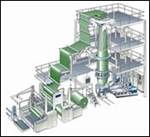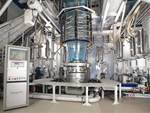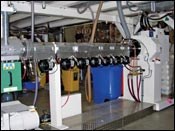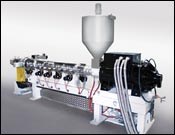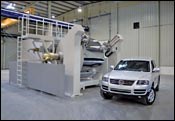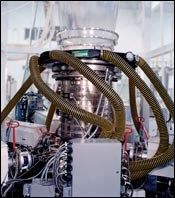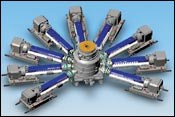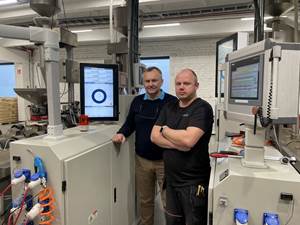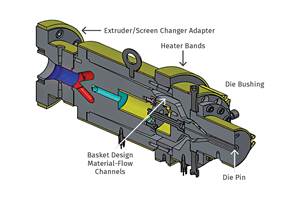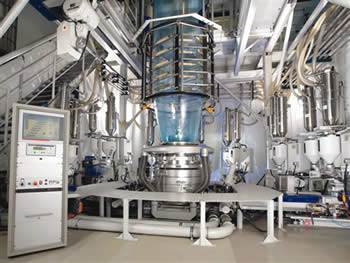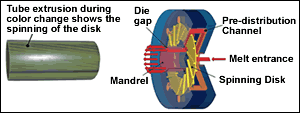What's New at the Show in EXTRUSION
It’s all about higher speeds and higher outputs at this year’s “K” show in Germany.
It’s all about higher speeds and higher outputs at this year’s “K” show in Germany. The most unusual new phenomenon at the show is high-speed (high-rpm) extrusion of thin sheet, film, and tube. You’ll see lots of (small) long, thin extruders designed to turn astronomically fast—some up to 1500 rpm instead of the 100 to 240 rpm of conventional extruders. They can more than double extruder output.
In addition, the show will highlight a trend toward larger extruders for cast film, especially PET, to gain output efficiency. Blown film machine builders will show new screws, dies, and air rings designed to raise output 20% to 30% and accommodate resin changes with greater flexibility. In pipe and profile, new systems also have more flexibility to change output and product sizes.
The need for speed
High-speed extruders first appeared in prototype at the last K show from several German machine builders and have been rapidly commercialized since then. Roughly 60 such machines are running in Europe, China, and the Middle East. There are none so far in North America. If you count a subset of new machines that run at 400 to 500 rpm—double or triple normal speed— there are roughly 60 more in the field.
Most of these high-speed machines extrude thin sheet for thermoforming. A few make pipe, wire, or cable; and one makes cast stretch film. The very high-speed models are all between 25 and 90 mm diam. and typically about a third longer than conventional extruders—36:1 to 38:1 L/D. They supply the same output as conventional extruders of 125 to 189 mm diam. and 24:1 to 30:1 L/D. Being so much smaller, the high-speed models have the advantage of much faster color and resin changes.
It may seem remarkable that an extruder can turn 10 or even 15 times faster than normal speed and not over-shear the plastic. The secret is that high-speed extrusion works only with low-viscosity materials—primarily PP, PS, and ABS. It’s under development at beta sites for PET, HDPE, and LLDPE. It doesn’t work with heat-sensitive PVC, PMMA, or PC.
Screw design is the most important part. High-rpm extruders are roughly a third longer than usual. They have deeper intake flights and a longer compression zone than normal screws and need a melting section roughly twice as long. High-rpm screws also need to mix without generating much pressure or heat, so they are very material-specific.
“You can’t simulate screw design for these machines because high-speed screws behave completely out of calculation, so they’re built by trial and error,” says Robert Preuner, head of R&D at SML Maschinengesellschaft mbH in Austria, which will be exhibiting a high-speed extruder at K. “PS is relatively simple, requiring only minor changes from a conventional screw. PP is more difficult at high speeds.”
All high-speed extruders use either a four-motor torque drive; a permanent-magnet, synchronous torque motor; or a high-torque AC motor directly coupled to the screw. The power choice determines the rpm capacity. For example, at least three K exhibitors will show machines using the motor that gives the highest speed capability in the industry—the four-motor CMG 240 drive (390 kw or 523 hp) from K & A Knoedler GmbH in Germany (represented in the U.S. by Henschel America). This model goes up to 1500 rpm and can handle an extruder of up to 75 mm diam. Larger CMG motors run at a maximum of 800 or 1000 rpm.
Who’s who in high-speed
At least five companies have built high-speed extruders, and all will be at K. These firms are still trying out different drive motors and experimenting with screw designs. German OEMs Kuhne GmbH and Battenfeld Extrusionstechnik GmbH (BEX, represented here by American Maplan) are the early leaders. Kuhne has 25 and BEX 30 machines installed. SML has five. Cincinnati Extrusion GmbH in Austria and Welex in the U.S. each have one. In the not-quite-so-high-speed category, Esde Maschinentechnik GmbH in Germany (also at K) has built about 50 machines and Welex three.
Kuhne will introduce a commercial high-speed model KI2 using a four-motor CMG drive. It comes in 60 and 70 mm diam. Both run at 400 to 1500 rpm. The 60-mm model produces 990 lb/hr of PP sheet; the 70-mm produces 3300 lb/hr. Output of PS sheet is 20% higher than for PP. Kuhne is testing screws for PET and HDPE. The system reportedly can tolerate regrind levels of up to 70%. A KI2 C (coex) model is also available. At K 2004, Kuhne showed a 70-mm prototype with a direct-drive synchronous, permanent-magnet motor from Oswald, which ran at up to 700 rpm.
BEX will show a new 75-mm extruder that runs at up to 1500 rpm with the four-motor CMG drive. BEX also has a 45-mm high-speed coextruder capable of up to 1500 rpm. At the last K show, the firm showed a 90-mm gearless BEX 1-90-30 D with a four-motor CMG drive and speeds of up to 440 rpm.
SML will bring a 75-mm high-speed extruder to the K show, which runs at up to 1200 rpm with PP and PS, using a synchronous torque (“syn-torque”) motor. SML has also built what is believed to be the first high-rpm extruder for LLDPE stretch film, which has been running for over six months. LLDPE needs higher torque and requires special adaptations of the drive system, SML sources note.
Cincinnati Extrusion will show the commercial version of its high-speed Rapidex extruder (60-mm, 37:1), which uses a syn-torque motor from Siemens. The commercial version has more than 50% higher output than a prototype with a conventional DC motor, which ran 1800 lb/hr of PP pipe or 2200 lb/hr of PE pipe. The prototype was installed a year ago at pipe-maker Rehau in Viechtach, Germany and is now in normal production. It’s the first known system for HDPE pipe.
Welex built one 90-mm high-speed (1500-rpm) model last year using the four-motor CMG drive with cooling rolls sized for a 6-in. extruder. The line was sold to a Middle Eastern sheet producer. Two years ago, Welex had doubled the speed of its conventional 120-mm (4.5-in.) Mark III HS (high-speed) extruder to 500 rpm by changing from a 300-hp to 600-hp AC motor.
The higher-speed model uses the same 30:1 L/D with a modified screw and otherwise conventional components. Welex has installed three such machines. “This has none of the disadvantages of pushing the outer limits,” says president Frank Nissel, noting that if a hopper runs dry with a screw running at 1500 rpm, the damage can be frightful. Nissel also points out that because of differences in the electrical power grids, a machine that runs at 1500 rpm in Europe can run at up to 1700 rpm in the U.S.
Esde will exhibit five high-speed extruders (25 and 50 mm) for seven-layer barrier PP film. Esde offers a full range of 25- to 120-mm high-speed models for pipe, profiles, film, and sheet directly coupled to water-cooled AC torque motors. The 50- and 70-mm units have max. speeds of 326 and 445 rpm respectively. The 25-mm has a max. speed of 1100 rpm. Esde was the first to exhibit a high-speed extruder at the K ’98 show. It was a 35-mm unit with an AC torque motor and top speed of 600 rpm. Esde has since slowed down to gain the flexibility to process most resins except PVC.
Foam, sheet & cast film
Several machine builders will feature new cast film lines larger than any they have built before. Bruckner Formtec GmbH will present its newest and largest twin-screw extruder, capable of 11,000 lb/hr of cast film (minus edge trim). Bruckner’s largest extruder before that was an 6600-lb/hr unit for polished film. The new twin-screw extruder has 150 mm diam. and 34:1 L/D. It produces 150 ft/min of film, a rate that requires an unusually large, 2.4-meter diam. chill roll. Such rolls are typically 1 to 2 meters in diam. Bruckner has delivered three of the new giant machines for three-layer coex PET film for thermoforming.
Windmoeller & Hoelscher GmbH just built a 180-mm diam. single-screw. Before that, its largest was 150 mm. W&H is now designing a 200-mm model.
Welex also recently built its largest non-oriented PET line with a 175-mm (7-in.), 30:1 vented single-screw extruder and a modified V-PET screw. Welex will show a video of it running 6000 lb/hr of undried PET.
Davis-Standard has a new higher-output tandem foam extruder for PS with new barrel cooling, deeper screw roots, and a new mixing section. The first unit is in production. The new CMMX (cascaded modified mixing section) screw gets 15% higher outputs of PS foam and is said to be radically different from previous mixing screws. The line is available in two sizes with heating and cooling extruders of 120/165 mm and 165/175 mm.
Battenfeld Gloucester Engineering Co. said it will present a new film winding technology but provided no details before the show.
SML’s unusual shaftless turret slitter-winder (Winder 3000) has been expanded to wind 10 rolls at a time. Originally introduced at NPE, it wound only six up. Winder 3000 saves the step of rewinding from a master roll by winding individual rolls directly in production. Cores drop out of a magazine and are held between thin supporting arms with adjustable spacing for different roll sizes. SML has installed seven units.
More layers in blown film
Blown film coextrusion continues to add more layers. At the show, Macro Engineering & Technology will be talking about retrofitting layer-encapsulating feedblocks to upgrade an existing seven-layer film line to nine layers or a five-layer line to seven layers. Macro performed the first of these retrofits for EVOH and nylon barrier films three months ago on a line with a 20-in., seven-layer die.
Macro developed its patented feedblock encapsulation technology in 2000 to coextrude heat-sensitive and corrosive PVDC barrier resin and keep it from touching the die. The same principle has advantages with EVOH, which tends to form gels in contact with the die, and with nylon, which is notoriously difficult to purge from of a nine-layer die. When encapsulated, nylon can be purged in under an hour, Macro says. The retrofit requires only one additional extruder for the encapsulating tie layers and a slightly larger adapter.
Brampton Engineering has revealed the existence of its first 10-layer Aquafrost blown film line, which was installed two years ago at Wipak in Finland to make high-barrier PP film for stand-up pouches. It uses 10 extruders and a 450-mm SCD-3 pancake die. All Aquafrost dies are the same size, and extrude downward through a water-quenching chamber, which reportedly boosts output roughly 2.5 times above that of conventional lines. Brampton has eight Aquafrost lines installed.
Hosokawa Alpine American is building its first two nine-layer X-dies for delivery this December. A seven-layer version was introduced at NPE 2006. The X-die is a new side-fed, nested spiral-mandrel die with round flow channels in the predistribution section. A new patented spiral design reportedly eliminates port lines.
At least three blown film machine builders will show new multi-layer dies modified for shorter residence times and faster product changeovers. W&H will show a three-layer Maxicone C spiral-mandrel die with shorter, wider predistribution channels integrated into the spirals. During the show, W&H will run a demonstration at its plant of nine-layer barrier film with 1-micron-thick EVOH layers on a Maxicone die.
Kiefel in Germany also shortened residence time and reduced melt volume in its latest blown film die by optimizing spiral-mandrel distributors. The new die uses horizontal distributors (U.S. Pat. Application 20050214400) to avoid dead spaces behind inclined spirals and to lower overall die height.
Early this year, Reifenhauser built the first model of a new five-layer spiral-mandrel die, which was announced last year at NPE. This die also predistributes resin into the feed ports with enlarged melt channels to run three or five layers and a variety of resins, including copolyesters and K-Resin styrenic block copolymer. The first die was built for 200- to 400-mm layflat; a second is in the works for 300- to 650-mm.
Several new dual air rings at the show emphasize flexibility to make a range of products. Typically dual air rings are dedicated to high output of a single product. Eurochiller Srl in Italy will show a new model with three separate airstreams, one inside the bubble and one in each of the two air rings. It was first shown at Milan Plast last year.
Plast-Control in Germany will show a new automated dual air ring, the Pro-Con Magicflow Duo, which consists of a standard air ring below and a segmented air ring mounted on an elevator, so its height is adjustable on the fly. It reportedly increases output up to 30% over Plast-Control’s standard segmented Magicflow air ring. New lipset geometry accommodates a wide range of BURs from 1 to 5.3. Plast-Control also now builds its own complete vacuum-loading systems with dust separation.
Kuhne is showing a new Smart Lip Maximiser, which fits over small dies to enlarge the diameter up to twofold. With air pressure and cooling, this feature is also said to improve dart impact strength by about 20%, as well as tear resistance, gauge consistency, and output. It converts a 180-mm die to 350 mm, doubling output from 660 lb/hr to 1300 lb/hr, Kuhne says.
Kiefel says it increases output with a new mixing screw and water-cooled IBC stack. Kiefel will introduce Perfect Cool, the second generation of its water-cooled IBC, based on its ECP (enhanced cooling package) launched last year. Where ECP is sized for a 175-mm die to make form-fill-seal bags, Perfect Cool is designed to fit larger dies for other applications. A 16-in. die with Perfect Cool reportedly can run 1600 lb/hr of a low-melt-strength PE blend (70% LLDPE).
In blown film gauges, Kundig in Switzerland (represented here by D.R. Joseph) will show its new K-300 capacitance thickness gauge, which looks like its workhorse K-100 but has a sensor that can be replaced in seconds with minimal interruption of data collection. Changing a sensor previously took half an hour. Switching is now so fast that interchangeable sensors can be optimized for a particular film product. Kundig is also introducing free profile-monitoring software with any new Kundig thickness gauge. It’s a less sophisticated version of Kundig’s ProfileStar.net; a touchscreen PC to run it is not included.
Plast-Control will show a new twin-gauge system to measure thickness of EVOH barrier layers on-line. It combines a new noncontact capacitance gauge on the bubble with a highly accurate, horizontal noncontact capacitance gauge on the layflat. Plast-Control has patented the calculation method (U.S. Pat. 6646453 B2), which uses the second gauge to correct measurement errors from the first gauge. The first two systems were installed this year on agricultural film lines with 1.8-m dies producing 6-m layflats.
At its in-house demonstration during K, W&H will show new Easy Change software that reportedly speeds product changeovers by integrating more machine settings than other automatic start-up programs for blown film. EasyChange can be used on most W&H lines delivered since 2000, provided they have frequency-controlled air-ring blowers and Optifil automation.
Macro is showing for the first time a commercial version of its small edge guide for blown film. The device moves film with an air cushion, not roller tension, and has an unusually small footprint of only 2 x 2 ft, regardless of film width. A typical z-shaped edge guide with steering rollers takes up 12 meters or more of 4-m-wide film (4 to 6 m before the guide, 4 m in the guide and 4 m afterward). A prototype was shown at NPE 2006.
Pipe and profile news
Several machine builders will show new ways to adjust pipe output and size. American Kuhne will show a series of modular extruders with interchangeable barrels to change diameter, L/D, and throughput (see p. 17 for details).
KraussMaffei will introduce a new KMD 63 K/P conical twin-screw coextruder fitted for two different screw geometries, giving it an output range from 120 to 480 lb/hr. This allows it to apply different thicknesses of color coating or virgin layers.
KraussMaffei also increased the range of dimensional changes possible with its QuickSwitch system for PVC pipe, which allows pushbutton conversion of pipe diameter on the fly. It can now be adjusted from 90 to 160 mm vs. a max. of 140 mm when introduced last year at NPE. A change in the die reduces the drawdown and shrinkage of the PVC, which increases the adjustment range.
Several machine builders will exhibit energy-saving modifications of single- and twin-screw extruders for PVC pipe and profiles. Cincinnati Extrusion reportedly cuts energy consumption 30% to 35% with improved barrel insulation and use of AC motors on its twin-screws. It claims similar savings on single-screws with a new low-shear barrier screw plus AC motors.
Cincinnati Milacron will present its recently introduced “Plug-and-Play” package for rapid entry into wood-plastic composite profiles. Introduced at Chinaplas this year in Guangzhou, the complete system combines Milacron’s TC 86 conical twin-screw with material-handling auxiliaries from O.A. Newton plus downstream cooling and cutting equipment.
For window profiles, Battenfeld will introduce a new, very-high-output parallel counter-rotating twin-screw extruder, BEX 2-135V Plus, capable of 2200 lb/hr of dual-strand window profiles. It uses a 58,000-Nm torque motor and direct drive for about 30% higher output. The first unit is running commercially in Germany.
Cincinnati Extrusion increased output of its Monos series of single-screw extruders by 40% with a grooved feed throat, deeper screw flights in the intake zone, and also temperature control in the feed zone. The newly enhanced Monos+ line encompasses five extruders from 45 to 120 mm.
Cincinnati Extrusion is also introducing a basic, low-cost version of its ExcDat data-collection and storage software. ExcDat collects data on up to 50 variables via Ethernet from extruders’ EXc control systems. The basic package can be licensed for 2900 Euros, downloaded from a CD, and later upgraded.
Related Content
New Rotary Die and Cam Lock Design for Tubing
NPE2024: New design enables quick and easy assembly and disassembly of the crosshead, and eliminates the socket head cap screws.
Read MoreHigh-Output Extruder Series Now Comes in Smaller Size
Series offers higher output, lower melt temperatures and energy savings.
Read MoreOnline X-Ray Inspection Boosts Extrusion Quality
Höhle uses Sikora’s x-ray measuring systems for inline quality control of extruded microducts.
Read MoreHow to Select the Right Tooling for Pipe Extrusion
In pipe extrusion, selecting or building a complementary set of tooling often poses challenges due to a range of qualitative factors. Here’s some guidance to help you out.
Read MoreRead Next
K 2004 News Preview: Extrusion
At K 2004, at least a half-dozen European machine builders will show new direct-drive extruders running gearless—or nearly gearless—drives with substantially higher rpm and output rates than conventional extruders of the same size.
Read MoreNPE 2006 News Wrap-Up: Extrusion
NPE 2006 presented a bevy of features to make film, sheet, pipe, and profile extrusion more efficient.
Read MoreK 2004 Extrusion: Outputs Rise, Downstream Units Gain Flexibility
The show was packed with new equipment for pipe and profile, including extruders redesigned for higher outputs and/or lower cost, plus new ways to adjust die and calibrator diameters or switch dies and calibrators more quickly.
Read More
